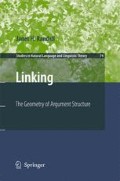Abstract
The job of a theory of linking is to make sense of the semantics-syntax mappings across all verb types. Can we predict, from the semantic arguments in a verb’s lexical representation, the number, type, and arrangement of syntactic arguments that the verb takes in a sentence? Consider number. It is true that for many verbs, the number of semantic arguments matches the number of syntactic arguments. For example, devour requires a “devourer” and a “devouree” – in the terms of traditional theta grids, an agent (internal argument, inside the square brackets) and a theme (external, outside the brackets) – both of which link to syntactic NP positions.
Access this chapter
Tax calculation will be finalised at checkout
Purchases are for personal use only
Preview
Unable to display preview. Download preview PDF.
References
Jackendoff, R. (1972). Semantic interpretation in generative grammar. Cambridge: MIT Press.
Carrier-Duncan, J. (1985) Linking of thematic arguments in derivational word formation. Linguistic Inquiry 16: 1–34.
Levin, B., and T. Rapoport (1988) Lexical subordination. Papers from the 24th Regional Meeting of the Chicago Linguistic Society, 275–289.
Pinker, S. (1989) Learnability and cognition: The acquisition of argument structure. Cambridge: MIT Press.
Chomsky, N. (1981) Lectures on government and binding. Dordrecht: Foris.
Jackendoff, R. (1990) On Larson’s analysis of the double object construction. Linguistic Inquiry 427–456.
Hale, K., and S.J. Keyser (2002) Prolegomenon to a theory of argument structure. Cambridge: MIT Press.
Pesetsky, D. (1982) Paths and categories, PhD dissertation. Cambridge: MIT.
Travis, L. (1984) Parameters and effects of word order variation, PhD dissertation. Cambridge: MIT.
Author information
Authors and Affiliations
Corresponding author
Rights and permissions
Copyright information
© 2010 Springer Science+Business Media B.V.
About this chapter
Cite this chapter
Randall, J.H. (2010). Conceptual Structure. In: Linking. Studies in Natural Language and Linguistic Theory, vol 74. Springer, Dordrecht. https://doi.org/10.1007/978-1-4020-8308-2_2
Download citation
DOI: https://doi.org/10.1007/978-1-4020-8308-2_2
Publisher Name: Springer, Dordrecht
Print ISBN: 978-1-4020-8307-5
Online ISBN: 978-1-4020-8308-2
eBook Packages: Humanities, Social Sciences and LawSocial Sciences (R0)

